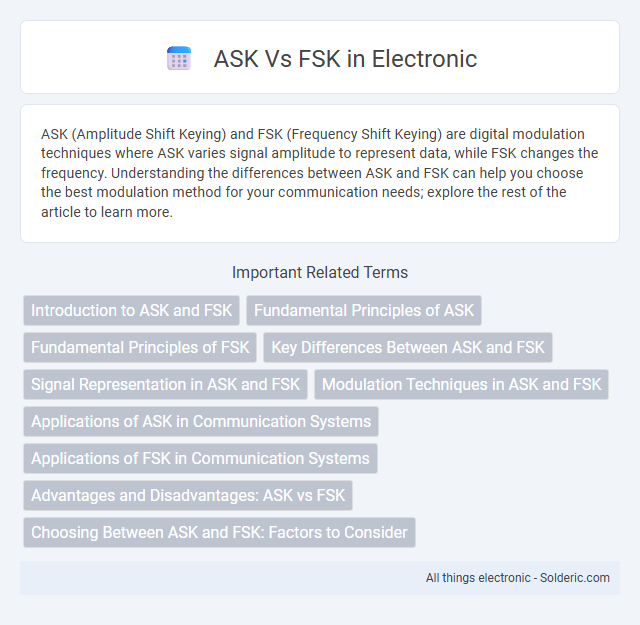ASK (Amplitude Shift Keying) and FSK (Frequency Shift Keying) are digital modulation techniques where ASK varies signal amplitude to represent data, while FSK changes the frequency. Understanding the differences between ASK and FSK can help you choose the best modulation method for your communication needs; explore the rest of the article to learn more.
Comparison Table
| Feature | ASK (Amplitude Shift Keying) | FSK (Frequency Shift Keying) |
|---|---|---|
| Modulation Type | Amplitude modulation | Frequency modulation |
| Signal Variation | Changes amplitude to represent data | Changes frequency to represent data |
| Noise Susceptibility | High (sensitive to amplitude noise) | Low (more resistant to noise) |
| Bandwidth Efficiency | Higher bandwidth efficiency | Lower bandwidth efficiency |
| Implementation Complexity | Simple to implement | More complex circuitry needed |
| Power Efficiency | Less power efficient | More power efficient |
| Common Applications | Low-speed data, optical communication | Radio transmission, wireless modems |
Introduction to ASK and FSK
Amplitude Shift Keying (ASK) and Frequency Shift Keying (FSK) are fundamental digital modulation techniques used in wireless communication. ASK modulates the amplitude of the carrier signal to represent binary data, making it simple but sensitive to noise and signal degradation. FSK varies the frequency of the carrier wave between distinct values to encode data, providing better noise immunity and reliability in noisy environments.
Fundamental Principles of ASK
Amplitude Shift Keying (ASK) encodes digital data by varying the amplitude of the carrier wave, representing binary values with different signal levels. This modulation technique relies on two discrete amplitude states, typically zero amplitude for binary '0' and a fixed amplitude for binary '1', making it straightforward but sensitive to noise and amplitude distortions. Understanding these fundamental principles helps you assess ASK's suitability in communication systems where simplicity and bandwidth efficiency are prioritized.
Fundamental Principles of FSK
Frequency Shift Keying (FSK) modulates data by shifting the carrier wave's frequency between distinct values, representing binary states, unlike Amplitude Shift Keying (ASK), which varies signal amplitude. FSK's fundamental principle relies on maintaining constant amplitude and phase, reducing susceptibility to noise and improving signal integrity during transmission. Your communication system benefits from FSK's robustness in environments with amplitude variations or interference, optimizing data reliability over ASK.
Key Differences Between ASK and FSK
ASK (Amplitude Shift Keying) modulates the amplitude of the carrier signal to represent data, while FSK (Frequency Shift Keying) varies the frequency of the carrier. ASK is more susceptible to noise and signal degradation, making FSK more robust in noisy environments. Understanding these key differences helps you choose the appropriate modulation technique based on signal integrity and transmission conditions.
Signal Representation in ASK and FSK
Amplitude Shift Keying (ASK) represents digital data by varying the amplitude of a carrier wave, using distinct amplitude levels to signify binary states, typically with one amplitude indicating a '1' and another indicating a '0'. Frequency Shift Keying (FSK) encodes data by shifting the frequency of the carrier wave between two discrete values, with each frequency corresponding to a binary digit, ensuring constant amplitude throughout transmission. While ASK signals fluctuate in amplitude and maintain a constant frequency, FSK signals maintain constant amplitude and vary frequency to convey information.
Modulation Techniques in ASK and FSK
Amplitude Shift Keying (ASK) modulates the signal by varying the amplitude of the carrier wave according to the digital data, with binary '1' represented by a high amplitude and binary '0' by no or low amplitude. Frequency Shift Keying (FSK) changes the frequency of the carrier wave between two distinct values, where one frequency corresponds to binary '1' and another to binary '0'. Both ASK and FSK are fundamental digital modulation techniques widely used in data communication, with ASK favored for simplicity and FSK for greater noise immunity.
Applications of ASK in Communication Systems
Amplitude Shift Keying (ASK) is widely used in optical communication systems and low-frequency radio transmissions due to its simple implementation and cost-effectiveness. Its applications include remote controls, RFID tags, and modems where bandwidth efficiency and noise resilience are less critical. ASK is favored in scenarios requiring straightforward demodulation and minimal hardware complexity.
Applications of FSK in Communication Systems
FSK (Frequency Shift Keying) is widely used in communication systems for its robustness in noisy environments, making it ideal for telemetry and low-speed data transmissions such as in RFID and wireless sensor networks. Your choice of FSK can enhance signal integrity in applications like modem communications, caller ID systems, and Bluetooth devices, where reliable data decoding is critical. Unlike ASK (Amplitude Shift Keying), FSK's frequency variations offer improved noise immunity and better performance over longer distances.
Advantages and Disadvantages: ASK vs FSK
ASK (Amplitude Shift Keying) offers simplicity in implementation and lower bandwidth requirements, making it suitable for cost-effective systems. However, ASK is more susceptible to noise and signal degradation, reducing reliability in harsh environments. FSK (Frequency Shift Keying) provides better noise immunity and improved signal integrity, but demands more complex circuitry and wider bandwidth, affecting power efficiency and cost.
Choosing Between ASK and FSK: Factors to Consider
Selecting between ASK (Amplitude Shift Keying) and FSK (Frequency Shift Keying) depends on noise environment, bandwidth availability, and power efficiency. ASK is more bandwidth-efficient but susceptible to amplitude noise, making it suitable for low-noise channels. FSK offers better noise immunity and constant amplitude signals, ideal for wireless communication requiring robust performance under interference.
ASK vs FSK Infographic

 solderic.com
solderic.com